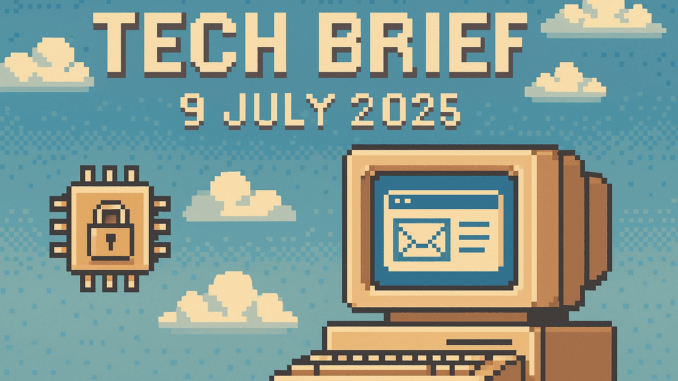
Anyone who spent Sunday mornings configuring Eudora filters will smile at today’s Thunderbird news. Tech Brief – 9 July 2025 brings stories that connect past and present in ways that feel both familiar and forward-looking. From Mozilla’s email client revival to fresh CPU vulnerabilities, we’re seeing patterns that echo through decades of computing history.
Thunderbird ESR Lands with Offline Indexing and Matrix Chat
Mozilla’s Thunderbird Extended Support Release arrives with proper offline message indexing and encrypted calendar handling. The ESR targets enterprise users needing stability over bleeding-edge features. Matrix chat protocol integration sits alongside AI-assisted drafting tools that process locally. No cloud dependency required.
The new unified tagging system works across folders. Backward compatibility preserves legacy add-ons. ESR support runs until Q3 2028, giving sysadmins breathing room.
This feels like pushback against webmail lock-in. While Gmail conquered casual users, Thunderbird serves the self-hosted email crowd. We all remember when email clients had personality beyond a web interface. Steven Dorner’s Eudora pioneered many filtering concepts that Thunderbird now perfects.
AMD Warns of TSX Side-Channel Vulnerabilities in Zen CPUs
AMD discloses “Transaction Leak” vulnerabilities affecting Zen 3 and Zen 4 architectures. The flaw exploits Transactional Synchronization Extensions (TSX, hardware-level transaction processing) to extract data across virtual machine boundaries. Performance penalties reach 34% for database workloads after patching.
The timing echoes 2018’s Spectre crisis. Speculative execution became a security nightmare overnight. BIOS updates roll out July 15. Kernel patches follow in Linux 6.11 and Windows 11 24H2. The CVE rating hits 8.1 on the CVSS scale.
For anyone maintaining on-premises infrastructure, this means another round of late-night patching. The performance hit particularly stings legacy applications that can’t easily migrate to newer architectures.
Google Cloud Wins £120M Contract to Train UK Civil Servants
The Cabinet Office awards Google Cloud £120M to make 100,000 civil servants tech-literate over three years. Training covers cloud infrastructure, AI ethics, and low-code development. Departments like DVLA and HMRC will migrate from COBOL mainframes to containerized workloads.
The programme prioritises Anthos hybrid management and Vertex AI. Legacy integration happens via Apigee API gateways. Phase 1 starts Q3 2025 with 20,000 DWP staff. Full rollout reaches completion by Q4 2027.
This mirrors Y2K-era modernisation projects many readers engineered. The challenge remains identical: bridging decades-old systems with contemporary infrastructure while maintaining service continuity. Google’s approach suggests cloud adoption finally reached bureaucratic systems.
Anubis v2.4 Blocks LLM Crawlers Using Packet Timing Analysis
Open-source project Anubis releases v2.4 with LLM crawler detection. The system identifies AI bots through TCP packet timing anomalies. Auto-blocking scrapers while allowing legitimate archivers achieves 89% accuracy across 1,200 deployments.
Kernel-level traffic shaping uses machine learning models trained on 47TB of bot traffic. The approach recalls BlackICE Defender’s port-blocking philosophy, updated for AI-driven threats. Cloudflare integration arrives Q4 2025.
For webmasters running independent sites, Anubis offers protection against content harvesting. The tool empowers smaller operators who lack enterprise-grade defences against AI data collection.
From the Wayback Machine
On This Day: 1982 – Disney released Tron, the first major film to use computer-generated imagery extensively. Steven Lisberger’s vision of digital worlds used 15-20 minutes of pure CGI. Companies like MAGI handled the iconic light cycle sequences. The film’s modest box office performance belied its lasting influence on computer graphics and gaming culture. Tron legitimised CGI as both art form and narrative tool, setting expectations for immersive digital environments that persist today.
What This Means for Tech Brief – 9 July 2025
Today’s stories reveal familiar patterns: open-source tools defending user control, hardware vulnerabilities requiring urgent patches, and established players adapting to AI disruption. Mozilla’s Thunderbird ESR preserves email client tradition while AMD’s TSX flaws remind us that performance and security remain perpetually at odds. Whether training civil servants or blocking bot crawlers, today’s solutions echo problems we’ve solved before. Just with different acronyms.
Sometimes the best innovation is keeping what worked while fixing what didn’t.
Missed yesterday’s Tech Brief? Catch up here.

Leave a Reply